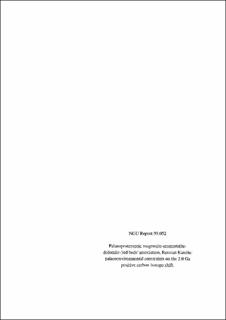| dc.contributor.author | Melezhik, V. A. | |
| dc.contributor.author | Makarikhin, V.V. | |
| dc.contributor.author | Medvedev, P. V. | |
| dc.contributor.author | Fallick, A. E. | |
| dc.date.accessioned | 2020-07-15T08:10:08Z | |
| dc.date.available | 2020-07-15T08:10:08Z | |
| dc.date.issued | 1999 | |
| dc.identifier.issn | 0800-3416 | |
| dc.identifier.uri | https://hdl.handle.net/11250/2665528 | |
| dc.description.abstract | Forkortet The ca. 2000 MA Tulomozerskaya Formation, Russian Karelia, representests the most 13C-rich carbonates (up to +18%)which have ever been reported. The implication of this excursion for our understanding of the coeval global geodynamic carbon cycle is not clear, but the interpretation of the maximum.... | |
| dc.language.iso | eng | |
| dc.relation.ispartofseries | NGU-Rapport (99.052) | |
| dc.rights | Navngivelse 4.0 Internasjonal | |
| dc.rights.uri | http://creativecommons.org/licenses/by/4.0/deed.no | |
| dc.subject | KARBONATITT | |
| dc.subject | PALEOZOIKUM | |
| dc.subject | DOLOMITT | |
| dc.subject | MAGNESITT | |
| dc.subject | BERGART | |
| dc.title | Palaeoproterozoic magnesite-stromatolite-dolomite-"red beds"assocation, Russian Karelia: palaeoenvironmental constraints on the 2.0 Ga positive carbon isotope shift. | |
| dc.type | Report | |
| dc.description.localcode | 46239 | |
| dc.source.pagenumber | 39 | |

